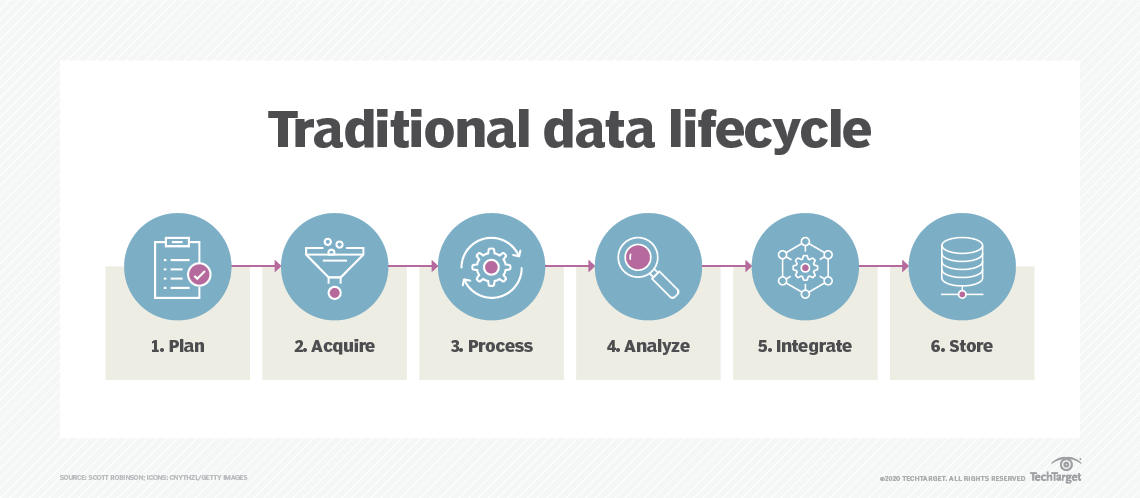
In the digital age, data is the lifeblood of organizations, pulsating through the veins of daily operations and strategic decisions. But have you ever wondered, “Which of the following most accurately describes data lifecycle management (DLM)?” Let’s dive into the world of DLM, unraveling its mysteries and showcasing its pivotal role in today’s data-driven landscape.
The Genesis of Data: Creation and Collection
At the heart of DLM lies the creation and collection of data. This initial phase is where data is born, springing from a myriad of sources like IoT devices, online transactions, and social media interactions. It’s a digital genesis, marking the start of a data element’s journey through the corporate ecosystem.
Safeguarding Digital Treasures: Storage and Security
Once created, data embarks on its next adventure – storage. But not just any storage; it needs a secure home. This stage is about finding the perfect balance between accessibility and protection, ensuring that data is safe from prying eyes yet readily available for those who need it. It’s like a digital fortress, guarding the treasures within.
The Sharing Economy: Utilization and Analysis
Data’s value is unlocked when it’s shared and analyzed. This phase is the digital marketplace, where data is exchanged, insights are gleaned, and decisions are made. It’s a bustling bazaar of information, buzzing with the potential to transform raw data into strategic gold.
Preserving the Past: Archival and Retention
As time marches on, some data fades from the spotlight, moving into the archival phase. Here, data is preserved, like ancient manuscripts in a library, ensuring that it can be retrieved when history calls. It’s a testament to the enduring value of information, even beyond its immediate use.
The Final Curtain: Deletion and Purging
Every story has an end, and so does the lifecycle of data. The deletion phase is the final act, where data is gracefully retired, making way for new information to shine. It’s a digital denouement, ensuring that the stage is set for the next generation of data.
The Symphony of Strategies: DLM vs. ILM
Diving deeper, we encounter the nuanced distinction between Data Lifecycle Management (DLM) and Information Lifecycle Management (ILM). While both play in the same orchestra, they perform different parts. DLM focuses on the macro, managing data at the file level, while ILM zooms in, ensuring the integrity and freshness of the data within. Together, they create a harmonious symphony of data management.
The Strategic Imperative: Why DLM Matters
In the grand scheme of things, DLM is not just about managing data; it’s about empowering businesses. It’s the backbone of data security, compliance, and operational efficiency. In a world where data breaches and compliance fines can spell disaster, a robust DLM strategy is the shield that guards the realms of data.
Navigating the Future: Building a DLM Strategy
As we look to the horizon, the question becomes, “How do we navigate the complex landscape of DLM?” The answer lies in understanding the stages of data’s life, recognizing the unique challenges and opportunities each presents, and crafting a strategy that aligns with your organization’s goals. It’s about charting a course through the digital wilderness, with DLM as your compass.
The Journey’s End? Always Looking Forward
As we conclude our exploration of Data Lifecycle Management, it’s clear that DLM is not just a process; it’s a philosophy. It’s about respecting the lifecycle of data, from cradle to grave, and recognizing its value at every stage. So, as we ponder the question, “Which of the following most accurately describes data lifecycle management (DLM)?”, let’s remember that DLM is the guardian of data’s legacy, ensuring that its story is told, its value realized, and its memory honored.
FAQs: Unveiling More Mysteries
- What triggers the start of the data lifecycle?
- The data lifecycle begins with the creation or collection of data, sparked by interactions, transactions, or observations in the digital realm.
- How does DLM differ from ILM?
- DLM manages data at the file level, focusing on the broader aspects of data’s journey, while ILM delves into the specifics within files, ensuring data integrity and relevance.
- Why is data deletion an important phase in DLM?
- Data deletion ensures that outdated or unnecessary data is removed, safeguarding against security risks and optimizing storage resources.
- Can DLM strategies evolve over time?
- Absolutely! As technologies and business needs change, DLM strategies should be revisited and refined to stay effective and relevant.
- How does DLM contribute to regulatory compliance?
- By managing data throughout its lifecycle, DLM helps ensure that data handling practices comply with legal and regulatory requirements, reducing the risk of fines and penalties.
- What role does DLM play in disaster recovery?
- A well-defined DLM strategy includes provisions for data backup and recovery, ensuring that data can be restored in the event of a disaster.

